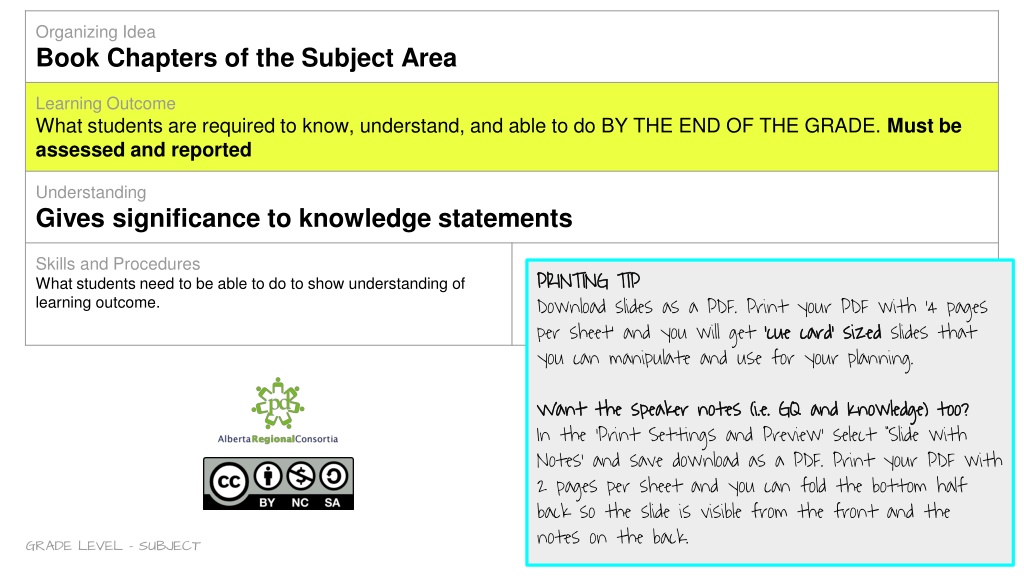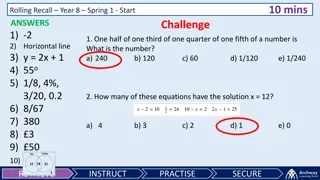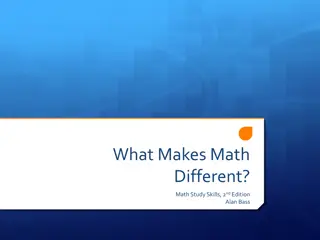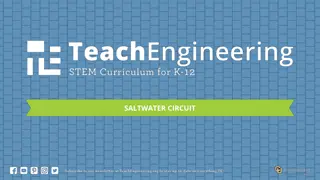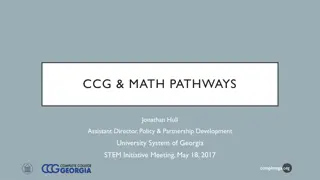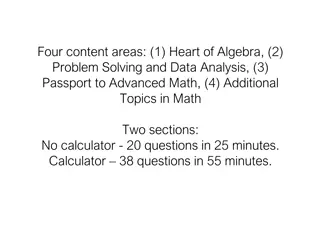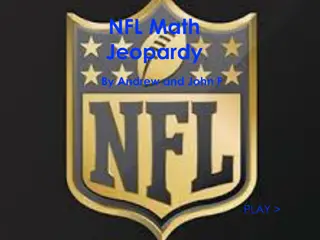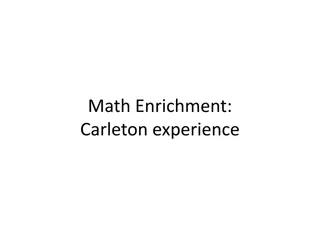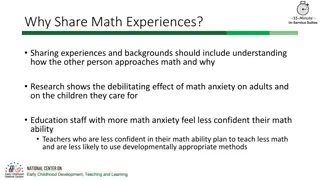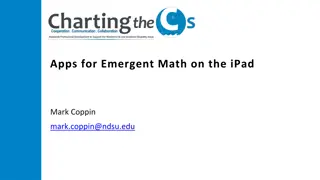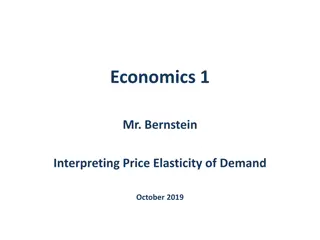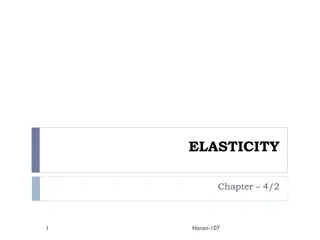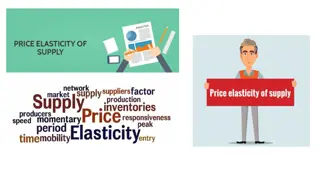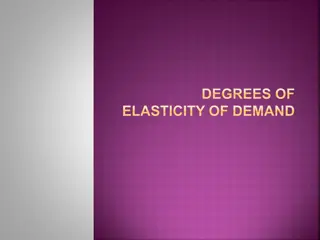Children's Quantity Exploration in Math
Dive into the world of quantity exploration with children as they investigate numbers up to 10. Discover how they recognize, represent, and relate quantities through various counting principles and skills. Develop their ability to count, subitize, compare sets, and solve problems in familiar contexts. This comprehensive kindergarten math curriculum fosters a deep understanding of quantity concepts essential for early mathematical development.
Download Presentation

Please find below an Image/Link to download the presentation.
The content on the website is provided AS IS for your information and personal use only. It may not be sold, licensed, or shared on other websites without obtaining consent from the author.If you encounter any issues during the download, it is possible that the publisher has removed the file from their server.
You are allowed to download the files provided on this website for personal or commercial use, subject to the condition that they are used lawfully. All files are the property of their respective owners.
The content on the website is provided AS IS for your information and personal use only. It may not be sold, licensed, or shared on other websites without obtaining consent from the author.
E N D
Presentation Transcript
Organizing Idea Book Chapters of the Subject Area Learning Outcome What students are required to know, understand, and able to do BY THE END OF THE GRADE. Must be assessed and reported Understanding Gives significance to knowledge statements Skills and Procedures What students need to be able to do to show understanding of learning outcome. PRINTING TIP Download slides as a PDF. Print your PDF with 4 pages per sheet and you will get cue card sized you can manipulate and use for your planning. PRINTING TIP cue card sized slides that Want the speaker notes (i.e. GQ and Knowledge) too? In the Print Settings and Preview select Slide with Notes and save download as a PDF. Print your PDF with 2 pages per sheet and you can fold the bottom half back so the slide is visible from the front and the notes on the back. Want the speaker notes (i.e. GQ and Knowledge) too? UPDATED APRIL 2022 GRADE LEVEL - SUBJECT
Organizing Idea Number Learning Outcome Children investigate quantity to 10. Understanding Quantity can be the number of objects in a set. Skills and Procedures Recognize a number of familiar objects as a quantity. Represent a quantity in different ways. Relate a numeral to a specific quantity. UPDATED APRIL 2022 KINDERGARTEN - MATH
Organizing Idea Number Learning Outcome Children investigate quantity to 10. Understanding A quantity is always counted using the same sequence of words (counting principle: stable order). A quantity remains the same no matter the order in which the objects are counted (counting principle: order irrelevance). A quantity can be determined by counting each object in a set once and only once (counting principle: one-to-one correspondence). The last number used to count represents the quantity (counting principle: cardinality). Any quantity of like or unlike objects can be counted as a set (counting principle: abstraction). Skills and Procedures Count within 10, forward and backward, starting at any number, according to the counting principles. UPDATED APRIL 2022 KINDERGARTEN - MATH
Organizing Idea Number Learning Outcome Children investigate quantity to 10. Understanding Quantity can be determined without counting. Skills and Procedures Subitize quantities to 5. UPDATED APRIL 2022 KINDERGARTEN - MATH
Organizing Idea Number Learning Outcome Children investigate quantity to 10. Understanding A quantity can be described relative to another quantity. A quantity can be described in relation to a purpose or need. Skills and Procedures Compare the size of two sets using one-to-one correspondence. Describe quantities relative to each other using comparative language. Describe a quantity in relation to a purpose or need using comparative language. Solve problems in familiar situations by counting. UPDATED APRIL 2022 KINDERGARTEN - MATH
Organizing Idea Number Learning Outcome Children interpret compositions of quantities within 10. Understanding A quantity remains the same no matter how the objects are grouped or arranged (counting principle: conservation). Skills and Procedures Identify a quantity in various groups or arrangements. Compose quantities within 10. Recognize various ways to make 5 and 10. UPDATED APRIL 2022 KINDERGARTEN - MATH
Organizing Idea Geometry Learning Outcome Children investigate shape. Understanding Shape is structured two-dimensional or three-dimensional space. Skills and Procedures Relate shapes in nature to various two-dimensional and three- dimensional shapes. Identify familiar two- and three-dimensional shapes. Investigate three-dimensional shapes by rolling, stacking, or sliding. Describe a shape using words such as flat, curved, straight, or round. UPDATED APRIL 2022 KINDERGARTEN - MATH
Organizing Idea Measurement Learning Outcome Children explore size through direct comparison. Understanding Size describes the amount of one measurable attribute of an object or a space. Skills and Procedures Identify measurable attributes of familiar objects to which size may refer. UPDATED APRIL 2022 KINDERGARTEN - MATH
Organizing Idea Measurement Learning Outcome Children explore size through direct comparison. Understanding Size may refer to only one measurable attribute at a time. The size of two objects can be compared directly. The size of an object can be described in relation to a purpose or need. Skills and Procedures Compare the length, area, weight, or capacity of two objects directly. Describe the size of an object in relation to another object, using comparative language. Describe the size of an object in relation to a purpose or need, using comparative language. UPDATED APRIL 2022 KINDERGARTEN - MATH
Organizing Idea Patterns Learning Outcome Children identify and create repeating patterns. Understanding A pattern is characterized by how the elements change or remain constant. Skills and Procedures Recognize repeating patterns encountered in daily routines and play, including songs or dances. Recognize change or constancy between elements in a repeating pattern. Predict the next elements in a repeating pattern. Create a repeating pattern with up to three repeating elements. UPDATED APRIL 2022 KINDERGARTEN - MATH
Organizing Idea Time Learning Outcome Children interpret time as a sequence of events. Understanding Time can be perceived as a sequence. Skills and Procedures Sequence events, limited to two events, according to time using words or ordinal numbers. Describe daily events as occurring yesterday, today, or tomorrow. UPDATED APRIL 2022 KINDERGARTEN - MATH
